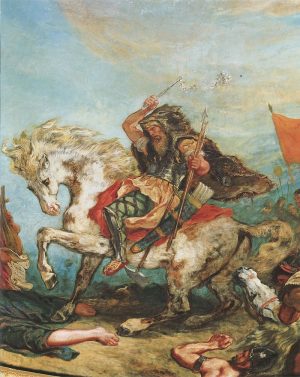Attila the Hun, known as the “Scourge of God,” had many legends related to or created about him. Some tell the mythos of the Hunnic ruler and folklores, which either include him as a character or its protagonist. In many instances, the king’s depictions or role in legends is positive.
Hero of the Kazakh people
Attila was known as Edyl in the mythology and epic poems of the Kazakh people and others in Europe. In one story, Edyl conquered Rome and shouted that he was the strongest warrior in history. Additionally, he claimed that no one could resist his army and declared he would no longer fight. In turn, his horse, known as Altynzhal, flew to heaven. After Edyl’s death, the conquered empire collapsed, and at times, Altynzhal appeared in the sky. His descendants ruled the empire for 300 years. The horse would return when Edyl was reborn.
Meeting with Pope Leo I
In the medieval period, an unknown chronicler wrote about the meeting of Attila and Pope Leo I, which Saint Paul and Saint Peter also attended. The pope promised the king a holy crown if the latter left Rome in peace. The two saints came after the pope, who sought mercy for the people, and spoke to Attila of his victories. The saints stood beside Leo and threatened the Hunnic king to obey the command of the pope. Appeased, the king promised lasting peace and withdrew his troops beyond the Danube.
Swords of Mars
Another legend about the Hun was the possession of the Sword of Mars or God. This legendary weapon’s name is due to the interpretation of Priscus from another culture. However, it simply means sword of God in Hungarian legends.
This sword exemplified for the Hunnic king and others a symbol of divine favor other than a weapon. It underlined the reputation of the king as the Scourge of God, a divine punisher. Other accounts and scholars note how Mars, the Roman god of war, gave the legendary weapon to the Hunnic King.
Battle of the dead
In 451 AD, the aftermath of the Battle of Catalaunian Fields led to one legend about the dead troops of Attila and their enemies. After the defeat of the Hunnic army, their leader focused on places near Rome. In one confrontation, a massacre transpired on both sides except for the military leaders. However, the souls of the dead fought for three days and three nights in a place near Rome.
Legend of Ursula
The Legend of Ursula has different versions, but all have connections to Attila and his empire. One version is how an English princess, Ursula, refused to marry the Hun prince leading to the abduction of 11,000 angels. Another version tells how St. Ursula, accompanied by 11 or 11,000 virgins, refused to copulate with the Huns. The result was their massacre of the virgins.
Mystery of the Gold Pit
In 452 AD, the Huns marched through Italy, and one of the longest sieges occurred in Aquileia, a Roman outpost and the origin of the Mystery of the Gold Pit. This legend associates the Hun king with the invasion of Aquileia. During the three-month siege, the inhabitants ordered their slaves to dig a pit to hide their treasure and recover it upon their return. However, no one reported finding the lost treasure since its inception.
Germanic legends
Depictions of Attila are also apparent in epic poetries. One is from a Germanic epic poem, Nibelungenlied, which portrayed the Hunnic king as Etzel, a noble and gentle figure. This portrayal coincided with several others who pointed out how he loved peace.
However, in Volsunga Saga, the king of the Huns was known as Atli, a cruel miser or someone who hoards wealth. In one section, it told the story of Gudrun marrying King Atli unhappily. However, the former killed two of the sons of the latter. Later, she would stab his Atlu while he was asleep after a funeral feast. Hence, there is a correlation between the stories of the death of Attila at the hands of his last wife in this Germanic narrative.
